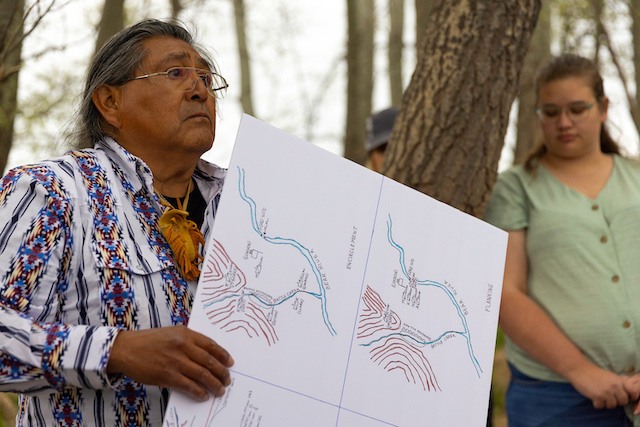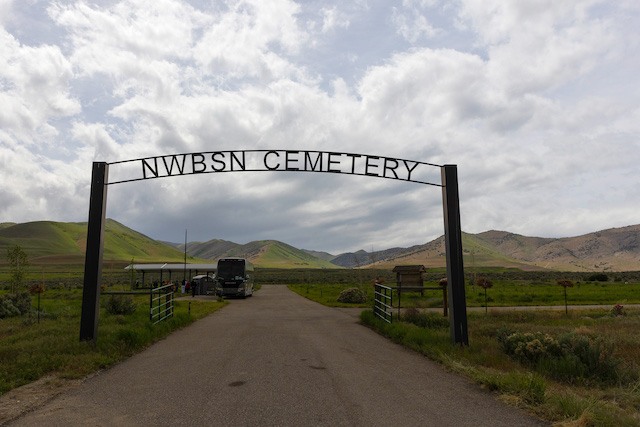The billboard project is expanding to Oregon
The complexities of teaching Indigenous history
Miacel Spotted Elk
High Country News

Rios Panchero, a member of the Northwestern Band of the Shoshone Nation, led a field trip to Washakie Cemetery in northern Utah during the second annual Railroads in Native America Gathering. Eugene Tapahe/High Country News
In Ogden, Utah, familiar questions of shared responsibility and shared histories surfaced -all at a three-day symposium on the railroad and Indian Country.
After a day’s worth of quiet rain, I stood, notepad in hand, and looked out over the field before me at the Washakie Cemetery in northern Utah.
In the wake of the 1863 Bear River Massacre, in which hundreds of Shoshone were killed by U.S. military forces, groups of tribal members stayed in Utah. They became known as part of the Northwestern Band of Shoshone, and, in the next two decades, many of them joined the Church of Jesus Christ of Latter-day Saints. It was the LDS Church that established the town of Washakie, named after a Shoshone leader, in 1880. For the next 80 years, Washakie’s Shoshone residents farmed the surrounding lands. After World War II, however, the town’s population steadily declined, and in 1960, LDS representatives, who were preparing for an upcoming land sale, ended up burning down Shoshone homes, both occupied and unoccupied ones. Since then, tribal members have looked after the deserted town and restored the old cemetery, creating a picnic area where people can gather.
It was there, in mid-May, that I attended the opening day of the Second Annual Railroads in Native America Gathering. An older group of attendees — historians, panelists and members of the event’s steering committee, most of them either deep into their careers or retired — silently shivered in the cold. As fog drifted over the nearby dairy fields, they leaned in to hear a Shoshone elder, Rios Panchero, talk about the land, the cemetery and the tribe’s relationship with the LDS Church.

“The funny thing was the Book of Mormon said when you accept the Gospel and you live the right way, one day all your people will be white,” Panchero said. He recounted an old story about a tribal elder. “He had a skin pigment (condition) that turned the skin all white. When he got old, they buried him. … He looked like one of the farmers out here on the ranch.”
The attendees, many of whom were white, seemed surprised at the warm manner in which Panchero spoke of the LDS church. Many waited for additional clarification. But there was none. The field trip — which was initially dedicated to learning about food systems and the transcontinental railroad’s historic relationship with the Northwestern Band of Shoshone — became instead a meditation on the tribe’s history and the cosmologies it shared with the Church of Jesus Christ of Latter-day Saints.
An individual’s personal interpretation of their people’s history is but a small freckle on their collective tribal memory; the history is incomplete without it, but it is still just a fragment of the whole story. When Panchero began to speak, bridging the history of his tribe and sermonizing about the divine relationship, I didn’t know what to think. I glanced at the faces closest to me, gazed with wandering eyes at others, curious about the role Panchero’s faith played in his effort to teach our group his tribal history. But after speaking with other participants, I allowed myself to reconsider, distancing myself from my first reaction. I initially thought, “Other people won’t know the actual history.” But what does that even mean?
In the official press release sent out by the Utah Division of Indian Affairs, the symposium was described as a “Native American-directed public history conference” that had been organized to reflect on the history and impacts of railroad expansion in the region. In the many similar events put on by state agencies or academic departments, the term “Native American-directed” appears to indicate that the history the audience is about to hear will be authentic, accurate and, most importantly, representative of the Indigenous community at its center. Throughout the symposium, however, I found myself asking the following questions: Can the state, or any institution that has been historically used to attack or exclude us, be expected to teach Indigenous history? Do such institutions have a responsibility to do so, and if so, how should they organize events like this? And how do we, as public-facing Native citizens, appropriately represent our histories without being misread by outsiders?
On the symposium’s second day, attendees and presenters sat in an ample gathering space at Ogden’s Railroad Museum. The same professors, tribal elders and college students who stood shivering in the field the day before now presented their wide-ranging work on the legacy of railroad expansionism in the museum, a former railroad station. One presentation, by Jennifer Graber of the University of Texas at Austin, focused on the Ghost Dance movement in the mid-to-late 19th century, a religious movement popularized by the Northern Paiute. At the movement’s height, the railroads occupied an unusual position in the Indigenous world. The railroads were a force of displacement and dispossession in the West, and yet they also enabled Natives to travel and share their ideas and spirituality with other Natives. This transfer of ideas and the physical objects that accompanied not only helped disseminate the Ghost Dance teachings, they also fostered a sense of kinship that cultivated the modern sense of intertribal community.
The keynote address focused on how the physical split of the railroad, the way it sliced across the landscape, led to a cultural schism on the Fort Hall Reservation. The presentations were less formal and clinical than your typical academic conference, allowing the audience to become familiar with a variety of topics in a more democratic space than the average lecture hall. Speakers offered Indigenous historical interpretations as well as reflections on the role Natives are often boxed into — wherein Indigenous history serves as a tonic to expel white guilt without ending the mythmaking of American exceptionalism.

American educators have had to grapple with the question of whether they have a moral obligation to weave Indigenous history into mainstream history. The ongoing effort to include more nuanced education on Indigenous histories frequently rejects the lionization of colonial figures as patriots and refuses to avoid the fact that Indians have long been portrayed as socially incorrigible. At the same time, any attempt to transform historical events into a clear narrative with a comprehensible plot often ends up as an idealized appraisal of the Indian experience, with romanticized images stacked atop each other, largely gleaned from ’90s blockbusters and contemporary activism backed by corporate patrons. How then do we escape this labyrinth?
Cutting through the noise and finding the most genuine way to explore and teach Indigenous histories isn’t easy, even — and maybe especially — for Indigenous people. James Toledo (Navajo), the program manager at the Utah Division of Indian Affairs, was in charge of the logistics of the symposium. In a conversation about how he approached organizing the event, Toledo reflected on the basic questions he carried as a child. “I remember as a kid kind of asking questions to my parents, ‘Why are things set up this way? Why is this part considered Indian land and this part is not Indian land?’” he said. The symposium, in his eyes, offered a way for the state of Utah to say clearly, “These are the outcomes of (U.S.) policies and how they have affected tribal communities all over the country.”
Toledo told me that he thought the success of future events like this one hinges upon the participation of tribal governments and their citizens. He saw the need to center the contemporary relationships Indigenous communities hold to their histories today.
But this requires a collaborative effort, and the tribes were not alone in organizing this event. In addition to the state of Utah, the Union Pacific Railroad and the Church of Jesus Christ of Latter-day Saints were among the symposium’s sponsors. From my vantage point, even after Panchero’s religious reflections at the cemetery, it did not appear that the sponsors actively dictated how the programming was selected or how critical it was that they, as complicit institutions, play a part — perhaps the most obvious concern of any joint public education effort. But the more I thought about their participation, the more I began to reflect on one of my initial questions.
Did these institutions and corporations have a moral obligation to fund this event?
When I think of the responsibilities that colonial institutions have to Indigenous communities, and both the hollow and the meaningful ways in which people fulfill those responsibilities — from the now-standard but often generic and corporatized land acknowledgments to symposiums like this one — I wonder how sincere institutions like Union Pacific and the LDS Church are in their participation. The almost obsessive impulse to correct the narratives of settler-colonial trauma in the corporate, academic and online spheres has scant relationship with any desire to materially alter modern Indigenous living conditions. Are the railroad and the church participating in order to “tidy up” the murkier facts of Indigenous history to make them easier for a general, usually whiter audience to consume? Or are they obligated to participate, because of those darker facets they were complicit in?
I still haven’t landed on a firm answer. Realistically, Indigenous history is not yet part of the established diet for the classroom or for other non-Native audiences. So the very act of teaching our histories and cultures, both as part of this continent’s original history and the contemporary American diaspora, will naturally introduce different perspectives that may invite entirely new ways of rethinking the role of this land’s history in our everyday lives. I also return to this basic fact: The very act of recounting American history, warts and all, is currently a politically and culturally contested one, with reactionary forces clamoring to return to the halcyon days of ignorant bliss. This isn’t to excuse or rubber-stamp the corporate or religious sponsors of symposiums, but to provide a true assessment of the nation’s limited appetite for really grasping the often-difficult lessons our shared pasts have to offer.
In this way, the three-day symposium was a kind of laboratory. We collectively interrogated the railroad and reflected on the flow of violence, information and religious piety that was born out of its introduction. We didn’t unanimously agree or accept every word of every presentation, and we didn’t need to. What mattered, ultimately, was that we spent our time collectively trying to understand the many ways that America’s past informs Indian Country’s present — including how we teach and digest that relationship.
History is an emotional and a necessarily complicated, even contradictory, process. But in an age of withering institutions, the very act of convening in Ogden to share our histories added to my own sense of determination: I want to assist in the broader task of re-establishing tribal nations as the textured, sovereign communities we have been since time immemorial.
Miacel Spotted Elk is an editorial intern at High Country News reporting on the Indigenous Affairs desk. Email her at miacel.spottedelk@hcn.org or submit a letter to the editor. See our letters to the editor policy.
External
Identification not yet made
UTTC International Powwow attendees share their rules for a fun and considerate event
Radio collaboration highlights importance of cooperation in a season of funding cuts for local media
A memorial in the Snow County Prison, now the United Tribes Technical College campus
Standing Rock Sioux Tribal Chairwoman Janet Alkire tells crowd, ‘We’re going to rely on each other’






